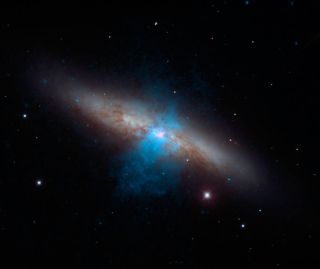
Pulsars are spherical, compact objects that are about the size of a large city but contain more mass than the sun. Scientists are using pulsars to study extreme states of matter, search for planets beyond Earth’s solar system and measure cosmic distances. Pulsars also could help scientists find gravitational waves, which could point the way to energetic cosmic events like collisions between supermassive black holes. Discovered in 1967, pulsars are fascinating members of the cosmic community.
Pulsars radiate two steady, narrow beams of light in opposite directions. Although the light from the beam is steady, pulsars appear to flicker because they also spin. It’s the same reason a lighthouse appears to blink when seen by a sailor on the ocean: As the pulsar rotates, the beam of light may sweep across the Earth, then swing out of view, then swing back around again. To an astronomer on the ground, the light goes in and out of view, giving the impression that the pulsar is blinking on and off. The reason a pulsar’s light beam spins around like a lighthouse beam is that the pulsar’s beam of light is typically not aligned with the pulsar’s axis of rotation.
Some pulsars also prove extremely useful because of the precision of their pulses. There are many known pulsars that blink with such precise regularity; they are considered the most accurate natural clocks in the universe. As a result, scientists can watch for changes in a pulsar’s blinking that could indicate something happening in the space nearby.
It was with this method that scientists began to identify the presence of alien planets orbiting these dense objects. In fact, the first planet outside Earth’s solar system ever found was orbiting a pulsar.
Because pulsars are moving through space while also blinking a regular number of times per second, scientists can use many pulsars to calculate cosmic distances. The changing position of the pulsar means the light it emits takes more or less time to reach Earth. Thanks to the exquisite timing of the pulses, scientists have made some of the most accurate distance measurements of cosmic objects.
Picture Credit : Google

